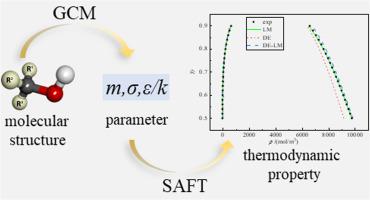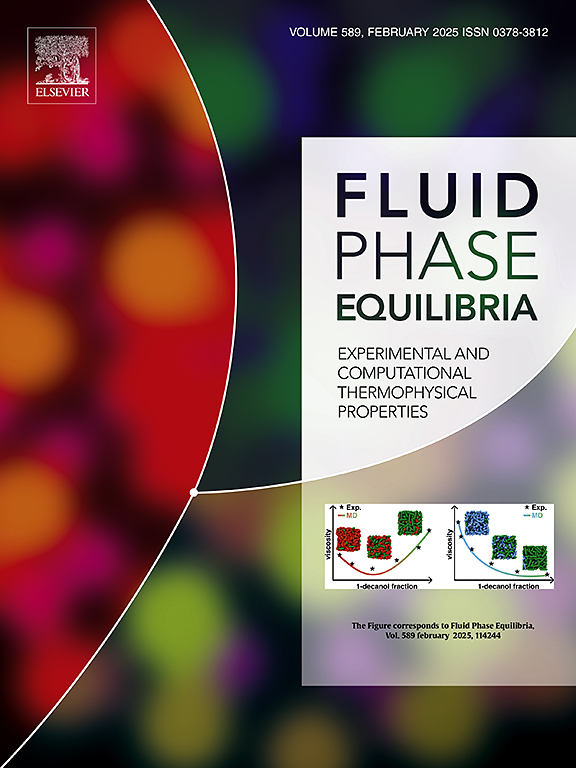为 PC-SAFT 状态方程开发卤代烃的新参数化策略和 GC 参数
IF 2.8
3区 工程技术
Q3 CHEMISTRY, PHYSICAL
引用次数: 0
摘要
统计关联流体理论(SAFT)状态方程(EoSs)已被广泛用于预测流体相平衡和热力学性质。对于每种流体,确定与组分相关的参数通常需要使用局部优化算法对实验数据进行拟合。由于 SAFT 型 EoS 采用高阶函数来描述不同的贡献项,因此具有高度的非线性。这种非线性导致存在多个局部最优值,使参数优化对初始值非常敏感。因此,确定优化过程的起点至关重要,但人们很少关注如何选择初始参数集。本文提出了一种基于群体贡献的方法,以确定优化过程的适当初始值,并将其应用于 Perturbed Chain SAFT(PC-SAFT)。本文评估了 11 个不同化学族共 74 种物质的 PC-SAFT 优化参数。饱和压力、液体密度和蒸汽密度的拟合结果显示,总体平均绝对相对偏差 (AARD) 分别为 0.050 %、0.042 % 和 0.151 %。本文还提供了卤代烃的组贡献参数,以估算 PC-SAFT 参数。此外,还对全局和局部优化算法进行了评估。结果表明,与局部算法相比,全局算法不仅需要更长的计算时间,而且精度也明显较低。全局算法的总体 AARD 值为 9.493%,而局部算法的 AARD 值为 0.068%。本文章由计算机程序翻译,如有差异,请以英文原文为准。

Development of a new parameterization strategy and GC parameters of halogenated hydrocarbons for PC-SAFT equation of state
Statistical Associating Fluid Theory (SAFT) equations of state (EoSs) have been extensively used in the prediction of fluid phase equilibria and thermodynamic properties. For each fluid, determining the component-dependent parameters typically involves fitting experimental data with a local optimization algorithm. SAFT-type EoSs are highly nonlinear due to the high-order functions used to describe different contribution terms. This nonlinearity leads to the presence of multiple local optima, making parameter optimization very sensitive to initial values. Hence, it is crucial to determine the starting point for the optimization process, yet little attention has been paid to how initial parameter sets are selected. In this paper, a method based on group contributions to establish an appropriate initial value for the optimization process is proposed and applied to Perturbed-Chain SAFT (PC-SAFT). The optimized PC-SAFT parameters for a total of 74 substances from 11 different chemical families have been evaluated. The fitting results for saturated pressure, liquid density, and vapor density showed overall average absolute relative deviations (AARD) of 0.050 %, 0.042 %, and 0.151 %, respectively. This paper also provided group contribution parameters for halogenated hydrocarbons to estimate PC-SAFT parameters. Additionally, an assessment of global and local optimization algorithms was conducted. The results demonstrate that the global algorithm not only requires longer computation time but also exhibits significantly lower accuracy compared to the local algorithm. The overall AARD for the global algorithm is 9.493 %, whereas for the local algorithm, it stands at 0.068 %.
求助全文
通过发布文献求助,成功后即可免费获取论文全文。
去求助
来源期刊

Fluid Phase Equilibria
工程技术-工程:化工
CiteScore
5.30
自引率
15.40%
发文量
223
审稿时长
53 days
期刊介绍:
Fluid Phase Equilibria publishes high-quality papers dealing with experimental, theoretical, and applied research related to equilibrium and transport properties of fluids, solids, and interfaces. Subjects of interest include physical/phase and chemical equilibria; equilibrium and nonequilibrium thermophysical properties; fundamental thermodynamic relations; and stability. The systems central to the journal include pure substances and mixtures of organic and inorganic materials, including polymers, biochemicals, and surfactants with sufficient characterization of composition and purity for the results to be reproduced. Alloys are of interest only when thermodynamic studies are included, purely material studies will not be considered. In all cases, authors are expected to provide physical or chemical interpretations of the results.
Experimental research can include measurements under all conditions of temperature, pressure, and composition, including critical and supercritical. Measurements are to be associated with systems and conditions of fundamental or applied interest, and may not be only a collection of routine data, such as physical property or solubility measurements at limited pressures and temperatures close to ambient, or surfactant studies focussed strictly on micellisation or micelle structure. Papers reporting common data must be accompanied by new physical insights and/or contemporary or new theory or techniques.
 求助内容:
求助内容: 应助结果提醒方式:
应助结果提醒方式:


